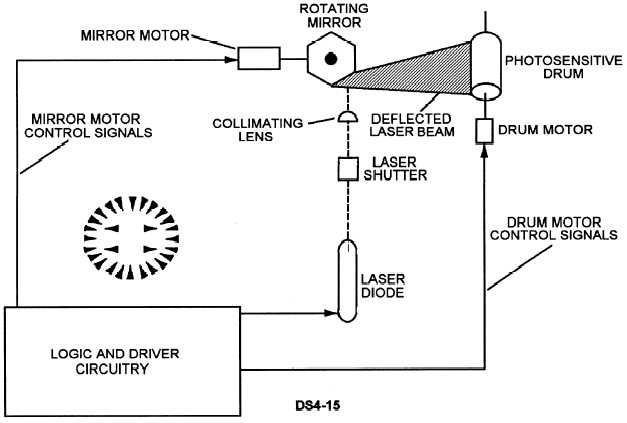The print drum is an aluminum cylinder coated with
a photosensitive material. This material is highly
conductive when exposed to light and has low
conductance in darkness.
The laser source is from a small laser diode that
generates a single wavelength light in bursts of a
millionth of a second or less. The laser is focused on the
drum and illuminates areas of the drum to form
characters.
To start a print cycle, the drum is first cleaned, both
physically and electronically. The cleaning blade wipes
any residual toner from the drum. The erase lamps are
turned on and neutralize any charge that maybe on the
drum. A negative charge of approximately -600V is
applied to the entire drum surface by the primary corona
wire.
The laser beam is applied to the drum, causing the
exposed areas of the drum to become positively
charged. Figure 12-14 shows the basic laser imaging
and scanning mechanisms. The laser beam is directed
through a shutter to a rotating hexagonal mirror. As the
mirror rotates, the area of the drum that the reflected
beam strikes changes. This is the horizontal scan of the
laser. To properly charge the drum, the laser shutter
controls when the laser beam will actually strike the
drum. When one horizontal scan is completed, the
drum is advanced one dot space and the process is
repeated. The characters are actually formed through a
series of dots, much like a dot matrix printer.
As the drum is rotated, it passes by the toner
reservoir. The toner consists of a very fine powder of
metal, dyes, and plastic particles that are easily attracted
by static electricity. As the exposed drum passes by the
toner, the positively charged areas of the drum attract
the toner while the other areas remain clean.
While all this is happening, the paper-feed section
of the printer picks one piece of paper from the tray.
The paper is lined up with the registration rollers and is
ready to be printed on. The paper is passed over the
transfer corona at the same time the charged area of the
drum is over the paper path. The transfer corona
charges the paper at a higher charge than the drum,
pulling the toner from the drum to the paper. The paper
never actually contacts the drum.
The image is now on the paper but it is not
permanent. The paper is fed through the fusing rollers.
The fusing rollers apply heat and pressure to the paper,
causing the toner to melt and permanently bind to the
Figure 12-14.—A laser imaging system.
12-12


